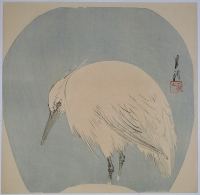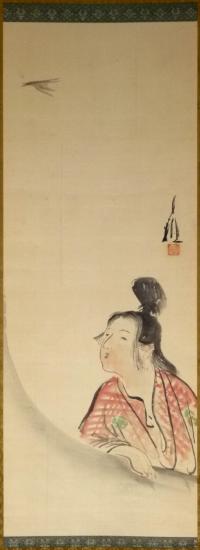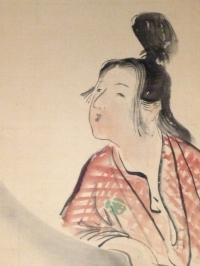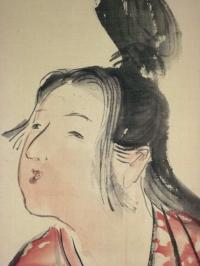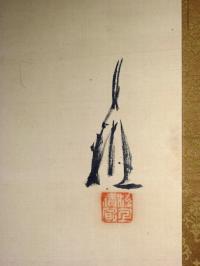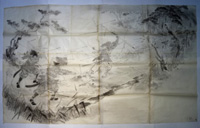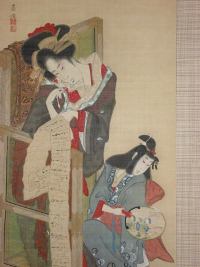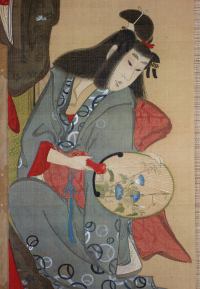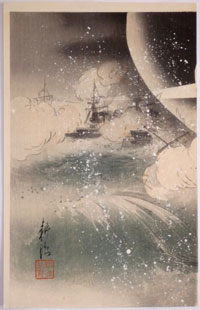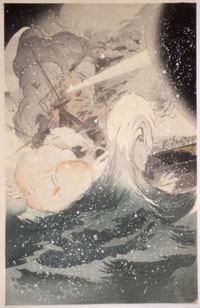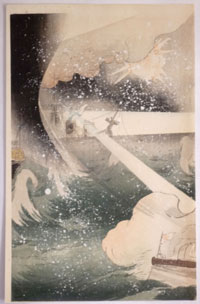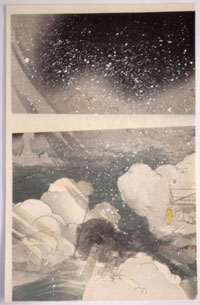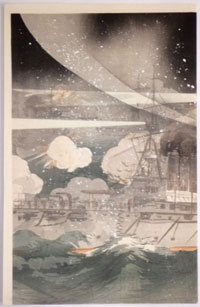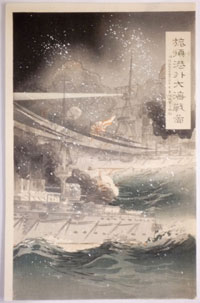Ogata GEKKO (1859-1920)
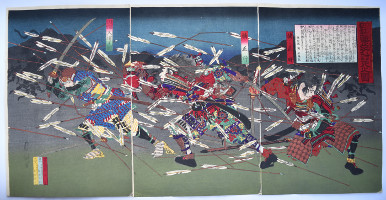
Click here to view image full size.
A triptych showing the last stand of the Kusunoki Clan at the Battle of Shijonawate in 1348. The event took place during the Nanbokucho wars when the Kusunoki Masatsura forces of the Southern Imperial Court were attacked at Yoshino by the Northern forces led by Ko no Moroyasu. Masatsura fought valiantly against a hail of arrows, eventually succumbing and committing suicide. . Published 1883 by Matsuo Danzo (who only appears to have survived one year). There is an earlier triptych version of this by Gekko in 1878. A later and far inferior reprint was published in 1901.
Superb impression, colour and condition with extensive burnishing. Signed Gekko ga.
Status: Sold
Ogata GEKKO (1859-1920)
Click here to view image full size.
An uncut fan print showing a great white egret. Rare.
Fine impression, colour and condition. Signed Gekko.
Status: Sold
Ogata GEKKO (1859-1920)
Click here to view image full size.
Gekko was a founding member of the Bunten and frequent prize winner. As well as designing prints, he illustrated magazines and decorated pottery. A talented artist who developed his own distinctive style. A young girl and a cuckoo. The first cuckoo traditionally heralds the arrival of summer and is usually shown flying across or near the moon – here represented by the circular window. And it might not be too fanciful to see the arrival of the cuckoo compared to the coming of age of the young girl. Sumi and colour on silk. Image size: 37 x 14 in; 94 x 35.5 cms. Very slight damage to bottom of washira mount. New box. Signed and sealed Gekko.
Status: Sold
Ogata GEKKO (1859-1920)
Click here to view image full size.
A set of five tanzaku paintings on silk mounted onto card. Each painting is 14.25 x 2.25 inches; 36 x 5.75 cms.
Very good conditions. Each signed Gekko and sealed.
Status: Sold

Click here to view image full size.

Click here to view image full size.

Click here to view image full size.

Click here to view image full size.
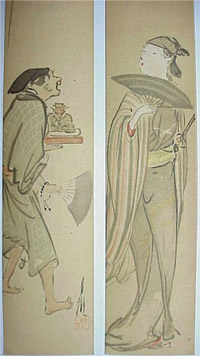
Click here to view image full size.
Ogata GEKKO (1859-1920)
Click here to view image full size.
The original preparatory drawing for a triptych published by Matsuki Heikichi, 1898, showing Tadanobu ( one of Yoshitsune’s men ) fighting the priest Yokogawa Kakuhan in Yoshinoyama. Sumi and light red on thin paper, each sheet 15 x 10.5 in; 38 x 26.5 cms. First sheet signed Gekko. Extremely good condition. Ex collection Mizuno Toshikata ( the artist, 1866 – 1908 ).
Status: Sold
Ogata GEKKO (1859-1920)
Click here to view image full size.
A large cartoon, sumi on thin paper folding out to 25.5 x 42 in; 65 x 106.5 cms. The subject is the Last Stand of the Kusanoki Clan. In fact Gekko designed a triptych of this subject in 1890 which is very similar to this large drawing. Why he made this large version is not known: Perhaps he was intending to make a painting or he just liked the subject. Very good condition. Ex collection Mizuno Toshikata ( the artist, 1866 – 1908 ).
Status: Sold
Tsukioka YOSHITOSHI (1839-1892)
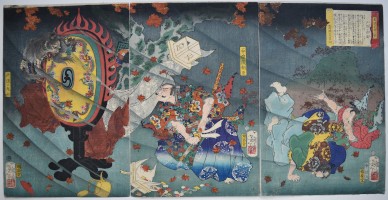
Click here to view image full size.
A triptych from a set Bidan musha hakkei, “Eight Views of Warriors’ Fine Tales.” This design Togakushi no seiran, “Clearing Weather of the Togakushi Mountains.” Princess Sarashina, who is actually a female oni called Momji, “Maple Leaves,” having transformed herself, is seen screaming from behind a giant drum and raising a high wind scattering maple leaves against Taira no Koremori Ason who draws his sword to kill her. Published by Sanoya Tomigoro, 1868.
Extremely fine impression of the earliest state. Fine colour. Slight marks on first sheet, otherwise very good condition. Signed Gekko Yoshitoshi hitsu.
Status: Available
Maki Bokusen (1736-1824)
Given names: Bokusen; Maki-Nobumitsu Bokusen; Gekkotei; Hokusen; Hokutei; Hyakusai; Maki Shin’ei; Suke-emon; Tokoro; Utamasa.
Bokusen was a Nagoya samurai of the local Owari Fief and ukiyo-e painter, printmaker and copperplate etcher. He was a student of Utamaro and also, as C H Mitchell states, a friend and acknowledged pupil of Hokusai although much of his work bears little resemblance to that of Hokusai.
Bokusen is known for his collaboration with Hokusai on the master’s Manga: It seems that the idea was conceived when Hokusai, at Bokusen’s invitation, went to Nagoya for an extended visit in 1811/12. Hokusai stayed for six months with Bokusen and during this time developed a circle of students and successfully cultivated his popularity in Nagoya. Hanshu Sanjin in his 1812 preface to Volume One of Hokusai’s Manga writes that over 300 spontaneous drawings were made during this visit. And this is what possibly inspired Bokusen to approach the legendary Nagoya publisher Eirakuya Toshiro, who had previously published illustrated book(s) by him, to turn Hokusai’s sketches into a book. Bokusen and another of Hokusai’s students, Tonansai Hokuun, are credited as copying Hokusai’s drawings in preparation for the woodblock cutter as the term “ko” or “revisers” is used in the colophon, suggesting that it was the two pupils who arranged the varied sketches.
Bokusen’s own published works include:
c1809 Kyogaen shohen. (Mad Sketches)
1809 Bokusen gafu (Album of Sketches by Bokusen)
1810 Hitoyo banashi (One Evening’s Talk)
1813 Shiki sanbaso (The Sanbaso in Four Seasons)
1814 Mushi no koe (Songs of insects). Bokusen and other artists
1815 Bokusen soga shashin gakuhitsu (Various Dreamings by Bokusen: A Study in Truthful Painting)
1816 Santei gafu. Bokusen and Hokusai publish a Manual for Illustration in Three Styles. The illustrations in this publication apply shin, gyo, and so styles to depict a range of subjects
1822 Kusa no na shu (Aki) (Collection of Autumn Grasses). Various artists including Bokusen
1823 Ippitsu gafu (A Book of Drawings Made by One Stroke of the Brush) Hokusai assisted by Bokusen
1827 Kusa no na shu (Haru fuyu) (Collection of Spring and Winter Grasses). Various artists including Bokusen
Bokusen’s work in copperplate etching is not well known to collectors of ukiyo-e, certainly not compared with his better recognised contemporaries Kokan (1747-1818) and Denzen (1748-1822) who used the technology for familiar subjects such as famous views of Edo to create a new type of image that integrated pictorial traditions of the West. Bokusen’s work with copperplate etchings was concerned with a scientific accuracy and faithfulness to the original illustration. For the Japanese translation Surgical Medicine, he produced copper-etching prints based on the illustrations in Lorenz Heister’s Heelkundige Onderwyzingen.
Bokusen’s books, paintings and prints are held in international museum collections.
Please follow this link to see an image of his painting Courtesan and Teenage Appentice in the Museum of Fine Art Boston.
To accompany this blog I am offering for sale an original Bokusen painting, full colour on silk.
KOTO (active 1894-1904)

Click here to view image full size.
Little is known of this artist ( whose name can also be read Koshu ), although he seems to have been a pupil of Gekko. A superb 6-sheet design of the great naval battle outside the port of Ryojun ( Port Arthur ). Ryojunkogai daikaisen zu. Shows the attack by Admiral Togo Heihachiro on the Russian destroyers on the night of the 8-9th February 1904. The Russian Vice Admiral Oskar Starks had three vessels hit by Japanese torpedoes. War was declared between Japan and Russia on the 10th February 1904. Published by Heikichi Kimura 1904. The finest design of this genre and period when the publishers had to produce speedy propaganda prints, quickly superseded by photographic processes. Shows the powerful searchlights raking the waves and vessels cleverly tying the six sheets together.
Very fine impression with extensive splashed gofun. Fine colour and condition. Signed Koto.
Status: Sold
Artists
( A to Z )
Kyogado ASHIKUNI ( Fl. c. 1807 – 1818 )
Gigado ASHIYUKI ( Fl. c. 1814 – 1833 )
Ki BAITEI ( 1734 – 1810 )
Takizawa BAKIN ( 1767 – 1848 )
Ono BAKUFU ( 1888 – 1976 )
Georges BIGOT ( 1860 – 1927 )
Kawamura BUMPO ( 1779 – 1821 )
Ippitsusai BUNCHO ( Fl. c. 1765 – 1792 )
Toyohara CHIKANOBU ( 1838 – 1912 )
Kishi CHIKUDO ( 1826 – 1897 )
Tsubaki CHINZAN ( 1801 – 1854 )
Eishosai CHOKI ( Fl. c. 1756 – 1808 ). See also SHIKO
Rekisentei EIRI ( Fl. c. 1790 – 1800 )
Keisai EISEN ( 1790 – 1848 )
Hosoda EISHI ( 1756 – 1829 )
Hosoda EISHO ( Fl. c. 1780 – 1800 )
Ichirakutei EISUI ( Fl. c. 1790 – 1823 )
Kikugawa EIZAN ( 1787 – 1867 )
Hirano HAKUHO ( 1879 – 1957 )
Elizabeth KEITH ( 1887 – 1956 )
Imao KEINEN ( 1845 – 1924 )
Yashima GAKUTEI ( 1786 – 1868 )
Ogata GEKKO ( 1859 – 1920 )
Adachi GINKO ( Fl. c. 1847 – 1897 )
Matsumura GOSHUN ( 1752 – 1811 )
GYOSAI. See Kawanabe KYOSAI
Hirano HAKUHO ( 1879 – 1957 )
Suzuki HARUNOBU ( 1724 – 1770 )
Kawase HASUI ( 1883 – 1957 )
Kitagawa HIDEMARO ( Fl. c. early 19th century )
Kinoshita HIRONOBU ( Fl. c. 1851 – 1870 )
Gosotei HIROSADA ( Fl. c. 1847 – 1863 )
Ichiryusai HIROSHIGE ( 1797 – 1858 )
Ichiryusai HIROSHIGE II ( 1826 – 1869 )
Ando HIROSHIGE III ( 1843 – 1894 )
Nakamura HOCHU ( Fl. c. late 18th to early 19th century )
Sakai HOITSU ( 1761 – 1828 )
Totoya HOKKEI ( 1780 – 1850 )
Teisai HOKUBA ( 1771 – 1844 )
Shunkosai HOKUEI (Active 1824-1837)
Katsushika HOKUGA ( Fl. c. 1830 )
Shotei HOKUJU ( Fl. c. 1789 – 1818 )
Katsushika HOKUSAI ( 1760 – 1849 ). Also used numerous other names such as: SORI, SHUNRO, SHINSAI
Shokosai HOKUSHU ( Fl. c. 1808 – 1832 )
KEISAI. See Kitao MASAYOSHI
Suzuki KIITSU ( 1796 – 1858 )
Kitagawa KIKUMARO ( Fl. c. ? – 1830 ). See TSUKIMARO
Kobayashi KIYOCHIKA ( 1847 – 1915 )
Torii KIYOHIRO ( Fl. c. 1737 – 1771 )
Torii KIYOMASA ( Fl. c. 1700 – 1722 )
KIYOMINE. See Torii KIYOMITSU II
Torii KIYOMITSU ( 1735 – 1785 )
Torii KIYOMITSU II ( 1787 – 1868 ). See KIYOMINE
Torii KIYONAGA ( 1752 – 1815 )
Torii KIYONOBU ( 1664 – 1729 )
Torii KIYONOBU II ( 1706 – 1763 )
Torii KIYOTSUNE ( Fl. c. 1757 – 1779 )
Isoda KORYUSAI ( Fl. c. 1767 – 1788 )
Ohara KOSON ( 1877 – 1945 ). See SHOSON
Torii KOTONDO ( 1900 – 1976 )
Toyohara KUNICHIKA ( 1835 – 1900 )
Utagawa KUNIHIRO ( Fl. c. 1815 – 1843 )
Ichiunsai KUNIHISA ( 1832 – 1891 )
Utagawa KUNINAO ( 1793 – 1854 )
Utagawa KUNISADA ( 1786 – 1865 )
Utagawa KUNISADA II ( 1823 – 1880 )
Utagawa KUNISATO ( ? – 1858 )
Utagawa KUNITERU ( 1808 – 1876 )
KUNITERU. See Utagawa SADASHIGE
Utagawa KUNITERU II ( 1829 – 1874 )
Utagawa KUNIYASU ( 1794 – 1832 )
Ichiyusai KUNIYOSHI ( 1797 – 1861 )
Santo KYODEN. See Kitao MASANOBU
Kawanabe KYOSAI ( 1831 – 1889 ). See GYOSAI
Okumura MASANOBU ( 1686 – 1764 )
KitaoMASANOBU ( 1761 – 1816 ). See Santo KYODEN
Kitao MASAYOSHI ( 1764 – 1824 ). See KEISAI
Oishi MATORA ( 1794 – 1833 )
Hishikawa MORONOBU ( Fl. c. 1618 – 1694 )
Nishimura NANTEI ( 1775 – 1834 )
Utagawa NOBUKATSU ( Fl. c. 1830 – 1844 )
Watanabe NOBUKAZU ( Fl. c. late 19th century )
Hishikawa RYUKOKU ( Fl. c. 1808 – 1816 )
Jokei RYUKOSAI ( Fl. 1772 – 1816 )
Gokitei SADAFUSA ( Fl. c. 1825 – 1850 )
Hasegawa SADAHARU ( Fl. c. 1830 – 1844 )
Gokotei SADAKAGE ( Fl. c. 1818 – 1844 )
Utagawa SADAHIDE ( 1807 – 1873 )
Hasegawa SADANOBU ( 1809 – 1879 )
Utagawa SADASHIGE ( Fl. c. mid 19th century ). See KUNITERU
Gofutei SADATORA ( Fl. c. 1825 )
Yamaguchi SHIGEHARU ( 1803 – 1853 )
Kitao SHIGEMASA ( 1739 – 1820 )
Nishimura SHIGENAGA ( 1697 ? – 1756 )
Nishimura SHIGENOBU ( Fl. c. 1724 – 1735 )
SHIKO. See Eishosai CHOKI
Ryuryukyo SHINSAI ( 1764 – 1820 )
Ito SHINSUI ( 1898 – 1972 )
Kojima SHOGETSU ( Fl. c. 1880 – 1890 )
SHOSON. See Ohara KOSON
Takahashi SHOTEI ( 1871 – 1945 )
Yamamoto SHOUN ( 1870 – 1965 )
Yamakawa SHUHO ( 1898 – 1944 )
Katsukawa SHUNCHO ( Fl. c. 1780 – 1795 )
Takehara SHUNCHOSAI ( Fl. c. 1772 – 1801 )
Katsukawa SHUN’EI ( 1762 – 1819 )
Katsukawa SHUNKO ( 1743 – 1812 )
Hishikawa SHUNKYO ( Fl. c. early 19th century )
Kubo SHUNMAN ( 1757 – 1820 )
Katsukawa SHUNSEN ( Fl. c. 1762 – 1830 )
Natori SHUNSEN ( 1886 – 1960 )
Gatoken SHUNSHI ( Fl. c. 1820 – 1828 )
Katsukawa SHUNSHO ( 1726 – 1792 )
Katsukawa SHUNTEI ( 1770 – 1820 )
Katsukawa SHUNZAN ( Fl. c. 1782 – 1798 )
Yamaguchi SOKEN ( 1759 – 1834 )
Ikeno TAIGA ( 1723 – 1776 )
Katsukawa TERUSHIGE ( Fl. c. 1715 – 1725 )
Mori TETSUZAN (1775-1841)
Migita TOSHIHIDE ( 1863 – 1925 )
Mizuno TOSHIKATA ( 1866 – 1908 )
Okumura TOSHINOBU ( Fl. c. 1717 – 1750 )
Utagawa TOYOHARU ( 1735 – 1814 )
Utagawa TOYOHIRO ( 1773 – 1828 )
Utagawa TOYOKUNI ( 1769 – 1825 )
Utagawa TOYOKUNI II ( 1777 – 1835 ). See TOYOSHIGE
Yamamura TOYONARI ( 1885 – 1942 )
Ishikawa TOYONOBU ( 1711 – 1785 )
TOYOSHIGE. See Utagawa TOYOKUNI II
TSUKIMARO. See Kitagawa KIKUMARO
Kitano TSUNETOMI ( 1880 – 1947 )
Toyokawa UMEKUNI ( Fl. c. 1816 – 1826 )
Kitagawa UTAMARO ( 1753 – 1806 )
Kitagawa UTAMARO II ( ? – 1831 )
Inoue YASUJI ( 1864 – 1889 )
Hiroshi YOSHIDA ( 1876 – 1950 )
Ipposai YOSHIFUJI ( 1828 – 1887 )
Utagawa YOSHIIKU ( 1833 – 1904 )
Utagawa YOSHIKATA ( Fl. c. 1841 – 1864 )
Utagawa YOSHIKAZU ( Fl. c. 1850 – 1870 )
Toyokawa YOSHIKUNI ( Fl. c. 1803 – 1840 )
Utagawa YOSHIMUNE ( 1817 – 1880 )
Ichiyosai YOSHITAKI ( 1841 – 1899 )
Utagawa YOSHITORA ( Fl. c. 1850 – 1880 )
Taiso YOSHITOSHI ( 1839 – 1892 )
Utagawa YOSHITSURU ( Fl. c. 1840 – 1850 )
Ichieisai YOSHITSUYA ( 1822 – 1866 )
Mori YOSHIYUKI ( 1835 – 1879 )
Shibata ZESHIN ( 1807 – 1891 )
